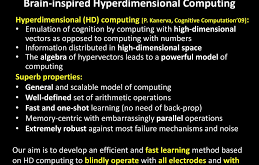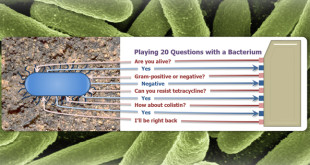As attack vectors increase with the burgeoning of the Internet of Things (IoT), the Defense sector is exposed to different risks that require increasingly advanced authentication techniques. Today’s threat players are using more sophisticated social engineering tactics, credential-stuffing botnets, and account takeover tactics to pull off all sorts of attacks. …
Read More »DARPA ElectRx developed automatic Self-Healing of Body by stimulating nerves by light, electricity, sound and magnets
Service members are subject to extreme physical injury and mental stress. Wounded soldiers often experience substantial pain, which must be addressed before returning to active duty or civilian life. Pain represents a serious and widespread problem both over the short term for wounded soldiers on the battlefield and during rehabilitation, …
Read More »Brain inspired Hyperdimensional computing for extremely robust brain-computer interfaces, biosignal processing and robotics
From an engineering perspective, computing is the systematized and mechanized manipulation of patterns. A representation is a pattern in some physical medium, for example, the configuration of ONs and OFFs on a set of switches. The algorithm then tells us how to change these patterns—how to set the switches from …
Read More »Biological Technologies Office of DARPA seeking R&D Concepts to harness the power of Biological systems for national security
The Defense Advanced Research Projects Agency’s Biological Technologies Office is seeking research-and-development concepts to help address Department of Defense requirements and other national security requirements. A FedBizOpps notice posted in April 2019 stated that BTO’s R&D scope covers a range of science and technology subject matters such as medicine, bioengineering, human-machine …
Read More »DARPA’s Friend or Foe to quickly identify both naturally occurring and adversary engineered bio-threats (pathogens) for force protection
Bacteria underpin much of our world, acting behind the scenes to affect the health and behavior of animals and plants. They help produce food, provide oxygen, and even reshape the environment through a vast array of biological processes. They come in a phenomenal number of strains—many still unknown—and thrive in …
Read More »Biological Synthesis of Metallic Nanoparticles by Bacteria, Fungi and Plants can be utilized for electromagnetic pulse protection, according to US Army
Nanoparticles have unique thermal, optical, physical, chemical, magnetic and electrical properties compared to their bulk material counterparts. These features can be exploited for next generation biosensors, electronics, catalysts and antimicrobials. Metallic nanoparticles are one important and widely studied group of materials, showing great diversity and many different uses Over …
Read More »Skin patches to diagnose diseases, monitor soldiers’ health, and stress levels in combat
Biomedical sensors present an exciting opportunity to measure human physiologic parameters in a continuous, real-time, and nonintrusive manner by leveraging semiconductor and flexible electronics packaging technology. These sensors incorporate a broad range of advances in microelectromechanical (MEMS), biological and chemical sensing, electrocardiogram (ECG), electromyogram (EMG), and electroencephalogram (EEG)-based neural sensing …
Read More »In the era of Electronic, and Cyber Warfare, Pigeons still provide alternative mode to transfer massive amount of data securely
The homing pigeon is a variety of domestic pigeon (Columba livia domestica) derived from the rock pigeon, selectively bred for its ability to find its way home over extremely long distances. The wild rock pigeon has an innate homing ability, meaning that it will generally return to its nest, (it …
Read More »Fake news is difficult to identify and fix, require new regulations and technologies for combating it.
Fake news or junk news or pseudo-news is a type of yellow journalism or propaganda that consists of deliberate disinformation or hoaxes spread via traditional print and broadcast news media or online social media. This type of news, found in traditional news, social media or fake news websites, has no …
Read More »Militaries race for Psychological warfare dominance, from Russia’s Gerasimov doctrine to China’s three Warfares to DARPA’s mind control
Psychological warfare involves the planned use of propaganda and other psychological operations to influence the opinions, emotions, motives, reasoning, attitudes, and behavior of opposition groups. Psychological warfare consists of attempts to make your enemy lose confidence, give up hope, or feel afraid, so that you can win. It is used …
Read More » International Defense Security & Technology Your trusted Source for News, Research and Analysis
International Defense Security & Technology Your trusted Source for News, Research and Analysis









